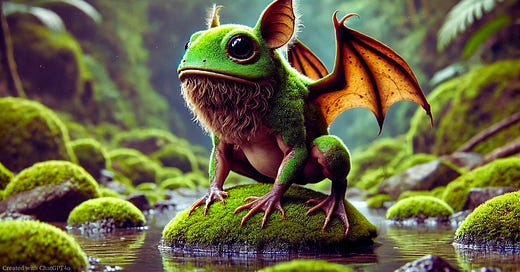📗Compendium | 8: Croakbat
by Acclaimed Interstellar Survival-Exploration Entrepreneur and Nature Documentarian Sir Davis Astenbarrow
This is Hanlon’s Reader, an independent author’s publication. Here you’ll find stories, books, essays, and other things. I’ll be tinkering away here for a while.
📗A Compendium of Beasts, Bugs, and Botany
1 | 2 | 3 | 4 | 5 | 6 | 7 | 8 | 9 | 10
📗A Compendium of Beasts, Bugs, and Botany
The Explorer’s Guide to Surface Life
Bearded Mossy Croakbat
Explorer’s Guide Contribution Written By Acclaimed Interstellar Survival-Exploration Entrepreneur and Nature Documentarian Sir Davis Astenbarrow

The Bearded Mossy Croakbat begins life with smooth, slick skin similar to many of Earth’s amphibians. Yet curiously, as the males reach maturity they grow a coarse scruff of wiry, brush-like fur beneath their chin which they will put to use once mating season begins. Then, the Croakbats don their true coats and compete for Nature’s ultimate privilege: reproduction.
These adaptable beasts have formed a unique symbiotic bond with an omnipresent species of fast-growing sheet moss colloquially referred to as “green carpet moss.” Their elaborate relationship illustrates the delicate, beautiful complexity of Surface ecosystems which are well worth the investment of intense study.
Female Mossy Croakbats must lay their unfertilized eggs among the soft moss beds above the waterline, where they will be exposed to predators and the elements. So first, she must find a suitable mate to protect them—and the selection process for this crucial task is quite the trial in and of itself.
Often traveling in clan-like groups made up of collections of smaller family units, Croakbats share close emotional bonds with their kind. They are aggressively protective of each member of their in-group, and are known to carry lifelong grudges against any encroachment by an out-group member—which includes careless human explorers, so tread with caution in their territory or risk long-term harassment!

The Mossy Croakbats’ spawning grounds must be coated in the green carpet moss, which is most often found along rocky, shaded stream banks where moisture gathers to sustain the moss. Areas above or below waterfalls are highly prized. At locations such as these, during the early warm season, the process begins.
First, the males must feed—enough to sustain them for several weeks at minimum. At this point, they have yet to grow their fuzzy green moss coats. They hunt aerial bugs, small fish-insectoid hybrids called Watergrub, and other protein-rich prey until the Croakbats become bloated and sluggish.
A successful male hunter will seek the waterline. Here, the female Croakbats will have gathered with their families in great numbers to find the best places to later deposit their egg sacs on the soft moss beds. Each clan stakes out a territory, with dominant family units getting the best real estate and defending their designated plots from potential usurpers.
The fattened males must approach without the use of their wings, and once they waddle their way over, they make use of the odd, scruffy “beard” below their jaw. They don’t dare approach the congregation of females yet! Instead they pour their focus into scraping their brushy beards over mossy rocks to dislodge it and then smear the bright green moss over their backs. Once a decent substrate has formed, the male Bearded Mossy Croakbat may finally rest.
As the first wave of moss-growers settles in, the looky-loos from nearby clans will find their way over to peer down their noses at the options the fertile females will have to choose from. In this, clan membership means less than the quality of the coat; whichever Croakbat has fed the most will have its engorged stomach pressing against specialized subdermal glands on its back, secreting a sticky glue-like substance from its skin packed with nutrients perfect for encouraging moss growth.
Once enough of the males’ verdant coats are deemed up to acceptable standards, the news travels to the females at their chosen nesting grounds and they finally seek out their mates. There’s a courtship ceremony involving a female waking their chosen mate from his slumber and leading him back to the well-protected clutch of eggs she’s left on their bed of green moss.
Then, in the most incredible sequence of this cycle, the males cover the eggs and simultaneously fertilize them while also shedding their shell of soft moss and its hardened nutrient layer. By slipping out of their green coat, they’ll leave a defensive barrier over the eggs which also serves as camouflage. And once the eggs reach maturity, it will be a source of nutrients they consume to begin their lives.
— Sir Davis Astenbarrow —
📗Short Stories | 📘Books | 📙Personal Essays | 💌Newsletter | ❓About | 🏡Home










